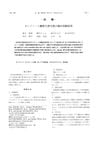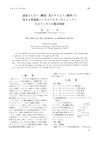 January 1994 in “JAPANESE JOURNAL OF CLINICAL PHARMACOLOGY AND THERAPEUTICS”
January 1994 in “JAPANESE JOURNAL OF CLINICAL PHARMACOLOGY AND THERAPEUTICS” Testosterone and fleece-flower root affect mouse hair growth.
 January 1992 in “Juntendo Medical Journal”
January 1992 in “Juntendo Medical Journal” Male pattern baldness is mainly caused by a hormone called dihydrotestosterone (DHT), and drugs that can block this hormone might help prevent hair loss.
 January 1989 in “Skin research”
January 1989 in “Skin research” The hair regrowth tonic effectively increased hair count and was safe for treating male pattern baldness.
 January 1981 in “The Journal of Toxicological Sciences”
January 1981 in “The Journal of Toxicological Sciences” Hydrocortisone 17-butyrate 21-propionate ointment caused reversible side effects like skin issues, weight gain, and organ changes in dogs.
 January 1978 in “Yukagaku”
January 1978 in “Yukagaku” Zinc pyrithione in shampoo or rinse reduces dandruff and itching.
 January 1974 in “Nippon Nōgei Kagakukaishi/Nihon Nougei Kagakkaishi”
January 1974 in “Nippon Nōgei Kagakukaishi/Nihon Nougei Kagakkaishi” Applying L-methionine and L-serine to the skin promotes the most hair growth.
 August 2022 in “Yakugaku zasshi”
August 2022 in “Yakugaku zasshi” Using a steam towel, l-menthol, and carpronium before applying minoxidil nanoparticles can increase its absorption and potentially improve hair growth.
March 2022 in “Japanese Journal of Complementary and Alternative Medicine” Hair thinning improved with basalt stone and placenta extract treatment but recurred when paused.
 January 2020 in “Journal of Clinical Dermatology”
January 2020 in “Journal of Clinical Dermatology” Dutasteride helps increase hair density in patients with female-pattern hair loss by activating a new growth mechanism.
 November 2019 in “Nosotchu”
November 2019 in “Nosotchu” Man had stroke possibly linked to hair loss medications finasteride and minoxidil.
January 2019 in “日本皮膚科学会雑誌” January 2018 in “日本薬理学会年会要旨集 =” Stopping finasteride improves sperm quality but not semen volume in young men.
January 2017 in “日本皮膚科学会雑誌” January 2017 in “Baioenjiniaringu koenkai koen ronbunshu”  January 2017 in “The Journal of Korean Medicine Ophthalmology&Otorhinolaryngology&Dermatology”
January 2017 in “The Journal of Korean Medicine Ophthalmology&Otorhinolaryngology&Dermatology” Early-onset male baldness is significantly linked to metabolic syndrome, suggesting those with early baldness should consider preventive treatment to reduce risk.
January 2016 in “日本性機能学会雑誌” January 2016 in “日本性機能学会雑誌”  January 2016 in “Journal of Clinical Dermatology”
January 2016 in “Journal of Clinical Dermatology” Trichoscopy helps diagnose and assess the severity of two types of hair loss diseases, androgenetic alopecia and alopecia areata.
 January 2014 in “The Journal of Korean Medicine Ophthalmology&Otorhinolaryngology&Dermatology”
January 2014 in “The Journal of Korean Medicine Ophthalmology&Otorhinolaryngology&Dermatology” The woman's hair loss improved significantly after treatment with acupuncture, pharmacopuncture, and needle-embedding therapy.
January 2010 in “Journal of Clinical Dermatology”  February 2009 in “Folia Pharmacologica Japonica”
February 2009 in “Folia Pharmacologica Japonica” Finasteride and minoxidil are the main effective treatments for hair loss from androgenetic alopecia.
 March 2008 in “Journal of Clinical Dermatology”
March 2008 in “Journal of Clinical Dermatology” Micropigmentation is a good and safe method to improve the look of scalp and eyebrow scars.
January 2008 in “Journal of Clinical Dermatology” October 2007 in “Journal of Korean Medicine Rehabilitation”  January 2005 in “Translational and Clinical Pharmacology”
January 2005 in “Translational and Clinical Pharmacology” HDMHG0401-10 improves hair loss in men with androgenetic alopecia and has no major side effects.
January 2005 in “JAPANESE JOURNAL OF CLINICAL PHARMACOLOGY AND THERAPEUTICS” January 2002 in “Journal of Clinical Dermatology”  January 1999 in “Journal of S C C J”
January 1999 in “Journal of S C C J” Certain growth factors regulate hair growth cycles, male hormones affect hair cycles, and drugs like Minoxidil and Finasteride can stimulate hair growth and inhibit male pattern baldness respectively.
January 1997 in “日本美容外科学会誌”  25 citations,
March 2019 in “Dermatologic therapy”
25 citations,
March 2019 in “Dermatologic therapy” Intralesional therapy for keratoacanthoma is effective and has fewer side effects than systemic treatments.

















